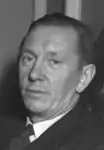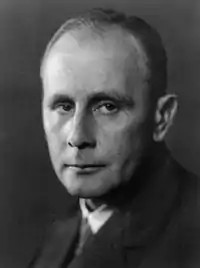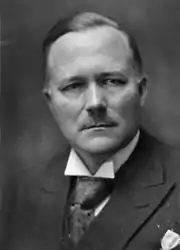| |||||||||||||||||||||||||||||||||||||||||||||||||||||||||||||||||||||
All 150 seats in the Norwegian Parliament 76 seats were needed for a majority | |||||||||||||||||||||||||||||||||||||||||||||||||||||||||||||||||||||
|---|---|---|---|---|---|---|---|---|---|---|---|---|---|---|---|---|---|---|---|---|---|---|---|---|---|---|---|---|---|---|---|---|---|---|---|---|---|---|---|---|---|---|---|---|---|---|---|---|---|---|---|---|---|---|---|---|---|---|---|---|---|---|---|---|---|---|---|---|---|
| |||||||||||||||||||||||||||||||||||||||||||||||||||||||||||||||||||||
 Results by county | |||||||||||||||||||||||||||||||||||||||||||||||||||||||||||||||||||||
| |||||||||||||||||||||||||||||||||||||||||||||||||||||||||||||||||||||
Parliamentary elections were held in Norway on 19 October 1936,[1] the last before World War II and the German invasion of Norway. The result was a victory for the Labour Party, which won 70 of the 150 seats in the Storting.[2]
During the election campaign, the conservative and liberal parties ran on the slogan "A free people in a free Norway."[2] They argued that a Labour Party victory would lead to terrorism, dictatorship, and Marxism.[2] A prominent controversial topic during the election campaign was the decision of the Labour government to allow Leon Trotsky to take up a domicile in Norway in 1935.[2]
Results
 | |||||
|---|---|---|---|---|---|
| Party | Votes | % | Seats | +/– | |
| Labour Party | 618,616 | 42.51 | 70 | +1 | |
| Conservative Party–Free-minded People's Party[lower-alpha 1] | 310,324 | 21.32 | 36 | +6 | |
| Liberal Party | 232,784 | 16.00 | 23 | –1 | |
| Farmers' Party | 168,038 | 11.55 | 18 | –5 | |
| Society Party | 45,109 | 3.10 | 1 | 0 | |
| Nasjonal Samling | 26,577 | 1.83 | 0 | 0 | |
| Christian Democratic Party | 19,612 | 1.35 | 2 | +1 | |
| Free-minded People's Party–Fatherland League[lower-alpha 1] | 19,236 | 1.32 | 0 | 0 | |
| Radical People's Party | 6,407 | 0.44 | 0 | –1 | |
| Communist Party | 4,376 | 0.30 | 0 | 0 | |
| Other parties | 4,132 | 0.28 | 0 | – | |
| Wild votes | 27 | 0.00 | – | – | |
| Total | 1,455,238 | 100.00 | 150 | 0 | |
| Valid votes | 1,455,238 | 99.44 | |||
| Invalid/blank votes | 8,230 | 0.56 | |||
| Total votes | 1,463,468 | 100.00 | |||
| Registered voters/turnout | 1,741,905 | 84.02 | |||
| Source: Nohlen & Stöver | |||||
Seat distribution
| Constituency | Total seats |
Seats won | |||||
|---|---|---|---|---|---|---|---|
| Ap | H–FV | V | B | KrF | Sfp | ||
| Akershus | 7 | 4 | 2 | 1 | |||
| Aust-Agder | 4 | 1 | 1 | 1 | 1 | ||
| Bergen | 5 | 2 | 1 | 2 | |||
| Buskerud | 5 | 3 | 1 | 1 | |||
| Finnmark | 3 | 2 | 1 | ||||
| Hedmark | 7 | 5 | 1 | 1 | |||
| Hordaland | 8 | 2 | 1 | 2 | 1 | 2 | |
| Market towns of Akershus and Østfold |
4 | 2 | 2 | ||||
| Market towns of Buskerud | 3 | 2 | 1 | ||||
| Market towns of Hedmark and Oppland |
3 | 2 | 1 | ||||
| Market towns of Møre | 3 | 1 | 1 | 1 | |||
| Market towns of Nordland, Troms and Finnmark |
4 | 2 | 1 | 1 | |||
| Market towns of Sør-Trøndelag and Nord-Trøndelag |
5 | 3 | 2 | ||||
| Market towns of Telemark and Aust-Agder |
5 | 2 | 2 | 1 | |||
| Market towns of Vest-Agder and Rogaland |
7 | 3 | 2 | 2 | |||
| Market towns of Vestfold | 4 | 2 | 2 | ||||
| Møre | 7 | 2 | 3 | 2 | |||
| Nord-Trøndelag | 5 | 2 | 1 | 2 | |||
| Nordland | 8 | 3 | 2 | 1 | 1 | 1 | |
| Oppland | 6 | 4 | 2 | ||||
| Oslo | 7 | 4 | 3 | ||||
| Østfold | 6 | 3 | 2 | 1 | |||
| Rogaland | 5 | 1 | 1 | 2 | 1 | ||
| Sogn og Fjordane | 5 | 1 | 1 | 2 | 1 | ||
| Sør-Trøndelag | 6 | 3 | 1 | 1 | 1 | ||
| Telemark | 5 | 3 | 1 | 1 | |||
| Troms | 5 | 3 | 1 | 1 | |||
| Vest-Agder | 4 | 1 | 1 | 1 | 1 | ||
| Vestfold | 4 | 2 | 2 | ||||
| Total | 150 | 70 | 36 | 23 | 18 | 2 | 1 |
| Source: Norges Offisielle Statistikk | |||||||
Notes
References
- ↑ Dieter Nohlen & Philip Stöver (2010) Elections in Europe: A data handbook, p1438 ISBN 978-3-8329-5609-7
- 1 2 3 4 Arneson, Ben A. (1937). "Workers' Parties Show Gains in Sweden and Norway". American Political Science Review. 31 (1): 97–99. doi:10.2307/1948050. ISSN 0003-0554.
- ↑ Nohlen & Stöver, p1451
This article is issued from Wikipedia. The text is licensed under Creative Commons - Attribution - Sharealike. Additional terms may apply for the media files.



